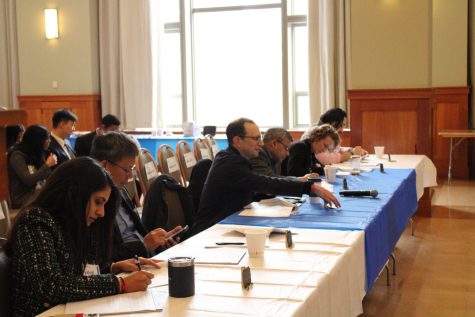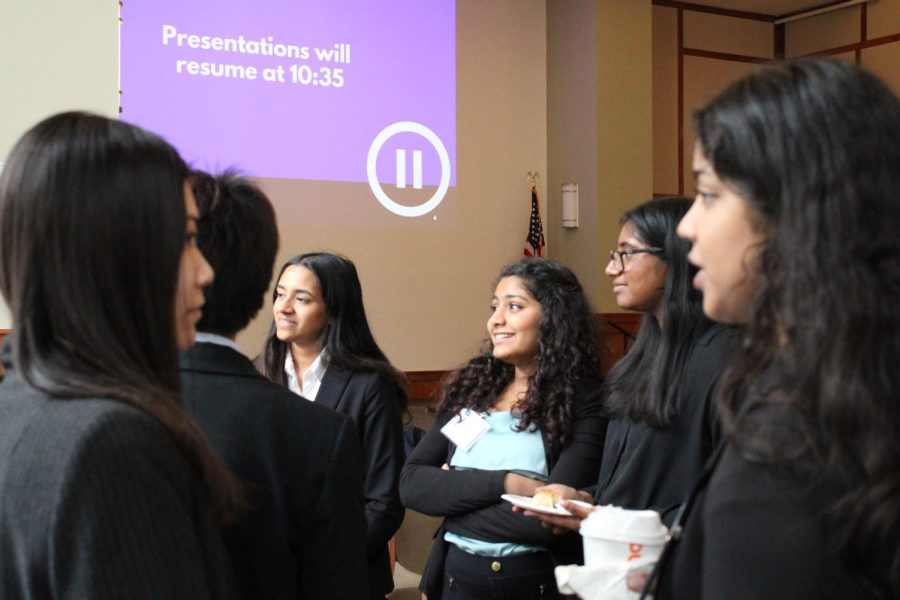NU ViTAL showcases student healthcare innovation
Participants in NU ViTAL’s pitch day event converse between presentations. During the event, students were challenged to pitch innovative healthcare products to a panel of judges. Photo courtesy NU ViTAL.
April 26, 2023
NU ViTAL, a Northeastern healthcare innovation organization, spent the spring semester supporting students in designing and prototyping healthcare products.
ViTAL ran an “Innovation challenge” pitch day event Feb. 2, allowing students to showcase creative new products to fellow students and a panel of judges, the fourth since the club’s formation in 2019. The pitch day’s theme focused on the connection between mental and gastrointestinal, or GI, health.
During the innovation challenge’s first round, teams of three to four participants showcased their innovative digital health solutions to issues of GI health. In the next round, the top four teams presented their solutions to a panel of judges, competing for a $1,000 prize.
Sarah Lowell, a third-year health science major, was the co-writer of the pitch and collaborated with fellow students, mentors and a dietician to research and plan the theme of this year’s healthcare innovation challenge.
“The event has an emphasis on digital health like hardware products, wearables or sensors,” Lowell said.

After reading the deliverables, judges picked the top four teams out of a total of 18 teams. Finalists were brought together to compete and present their products to six industry experts as well as several different sponsors. Sanjita Bhattacharya, a second-year cell and molecular biology major, managed the logistics of the event, which included entries from both Northeastern students and students from the greater Boston area.
Competitors “all have a common goal, which [is] really just a lifestyle improvement or symptom-lessening kind of technology,” Bhattacharya said. “This annual event celebrates student innovation, and is an opportunity for students to bring concepts we discussed during the year in our club and [try] their hand at innovating a new product.”
One of the competitors, Angie Chen, a second-year pharmaceutical sciences major, submitted a product with her team and was given a week to write their solution to the pitch.
Chen designed a mobile app called Gut Wise to help college students who have GI health issues. The main goal of the product was to create a tab on each university’s dining hall website for students to receive updates on the daily menus and nutrients. Gutwise has three different tabs: the dining hall tab, the community and engagement tab, and the recipe and kitchen tab. The target audience for the app is college-age students.
As health science majors, Chen and her team found the business side of the project the most challenging, she said, like learning about revenues and business proposals.
The current project is a prototype, and Chen hopes to expand the product to other universities or internationally and find more partners. She also hopes more students will use her product. The process involved brainstorming ideas, deciding how to present the information to the judges in a clear and effective way and background research on GI health issues.
“ViTAL is a great way for students to come together with students who are interested in the different aspects of healthcare such as the business aspects and the engineering aspects,” Chen said.
Another contestant, Sangeetha Punnam, is a first-year business administration major. Her group decided to focus on building a smartwatch wristband able to find the link between gastrointestinal health and mental health, give people a way to detect symptoms early on and make people more aware of the link between the two. The smartwatch analyzes sweat and heart rate data and displays information to the user, indicating whether they are over-stressed or dehydrated, or if they have certain electrolytes in their body.
Punnam and her team thought of three main ways of expanding their brand by tracking more biometrics, making it work with other markets and making it more affordable.
“ViTAL does a good job at bringing people from different majors together,” Punnam said.


















